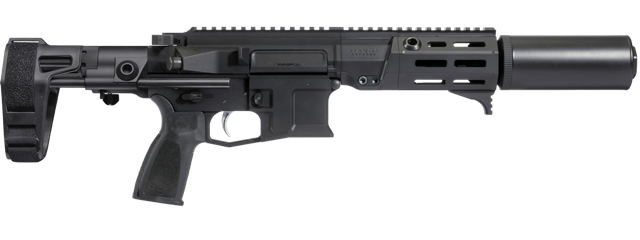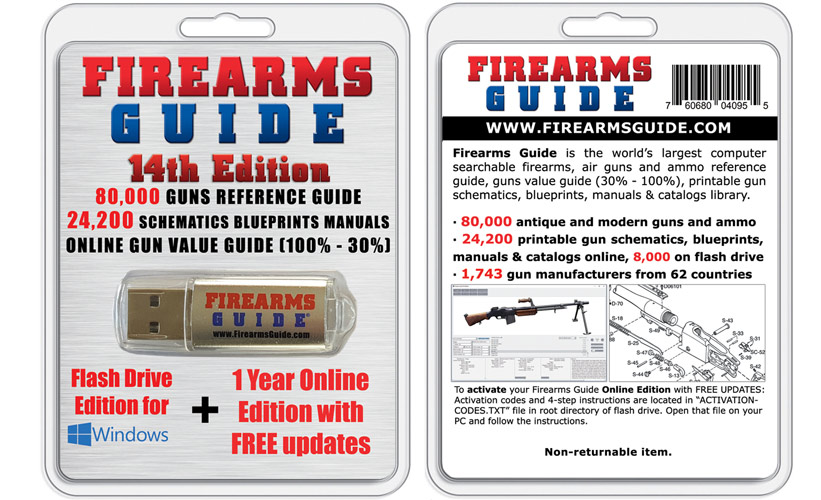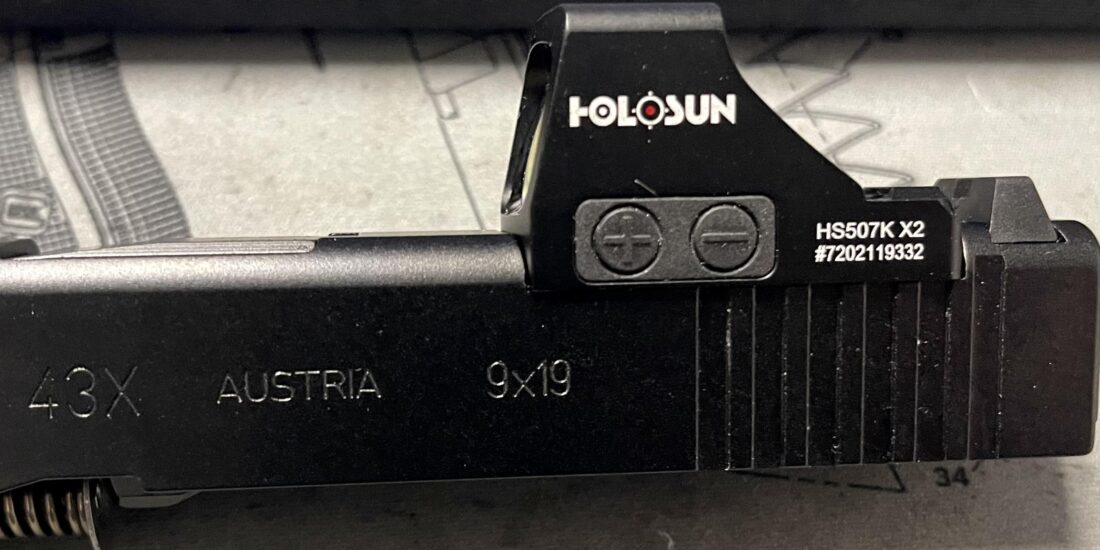Mil Spec AR Triggers: The More You Know
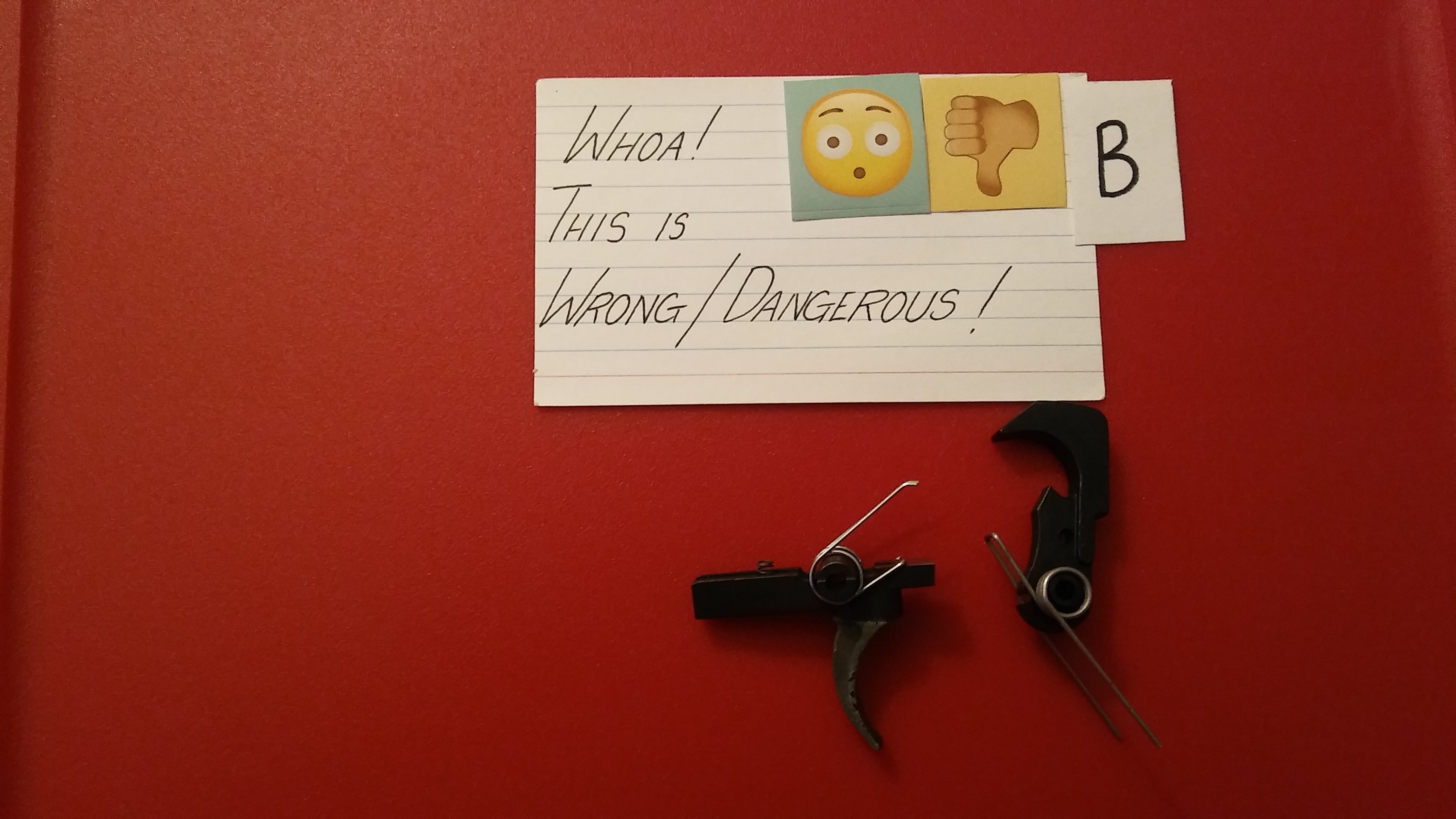
The trigger on the AR rifle is a wonder of design. The original model, commonly called “MIL SPEC” or military specification has been imitated, but not equaled as a rugged and reliable Fire Control Group (FCG). This is a misnomer, because the military NEVER bought a semi-automatic M-16. Their MIL SPEC triggers are select fire.
If you buy an AR build kit or a basic AR, you picked a good time. Prices are good right now. We’re not going into an armorer type dissertation, and we’ll try to keep things simple. Trigger tinkering is easy with these firearms, but whatever you decide to do is on you, so be responsible. Also understand that you cannot purchase ability, but you can purchase products to enhance it.
There are four key ingredients for accuracy involving good barrels, triggers, ammo, and rock solid fundamentals. By putting in the effort and money, you can become quite proficient with these firearms, using the components it came with. If you’re the sort who carries firearms as a profession, your department/organization has qualified armorers. If you’re a private person, you unfortunately have You Tube and other sinister avenues that can get you into trouble.If you start tinkering with parts like triggers, you can do more harm than good, and create an unsafe firearm.
You will hear terms like “entry level” and “professional grade” when it comes to this platform, and this typically refers to price. As you do your research, look for the term MIL SPEC. Although this doesn’t mean as much as it used to, it means that the vast majority of accessories will work within your new purchase, and this is good because every piece of the shooting sports equipment is perishable, and will eventually require change out. MIL SPEC refers to various tolerances, ranges, and parameters.
Trigger weights are allegedly around 4 to 5 pounds, if the trigger finger placement is correct. This is a facet you need to absorb pretty quickly, because proper finger placement is pretty darn important.
Here is the most important take away for you- “good trigger” is what works for you. What makes you happy will most likely not be the same for everyone. We learn through doing things, and share what we learn if asked to do so.
Your stock trigger will get smoother with time, and this is an excellent way to “wear it in”. Dry fire works as well as shooting for this. This means you’re actually using the tool. As a responsible adult, you need to avoid the type of person who decides that stock stuff isn’t good enough, and decides to modify it. This typically involves files, grinding, polishing, or maybe the good old Dremel tool. All of this is wrong, and here’s why.
Think of your FCG and other parts as M&M’s; the outer shell is hard to protect the softer stuff inside. The term of art is surface hardening. Removing the shell will lead to a calamity that cannot be predicted or controlled, and could potentially kill someone. If you know someone like this, please educate them. These types of videos are indeed out there.
There some internet experts who suggest that you to cut the legs on hammer springs to “lighten things up”. This is also hazardous, and quite possibly illegal. Avoid the Kitchen Gun Surgeon types, they are real, and they are a menace.
Then you have those intrepid souls who decide to do things themselves, and order parts kits. Provided you know what you’re doing, this is fantastic. This is a really good way to better understand form, fit, and function of the various parts.These kits oftentimes allow you to save a few bucks, but here are somethings I’ve noticed about them.
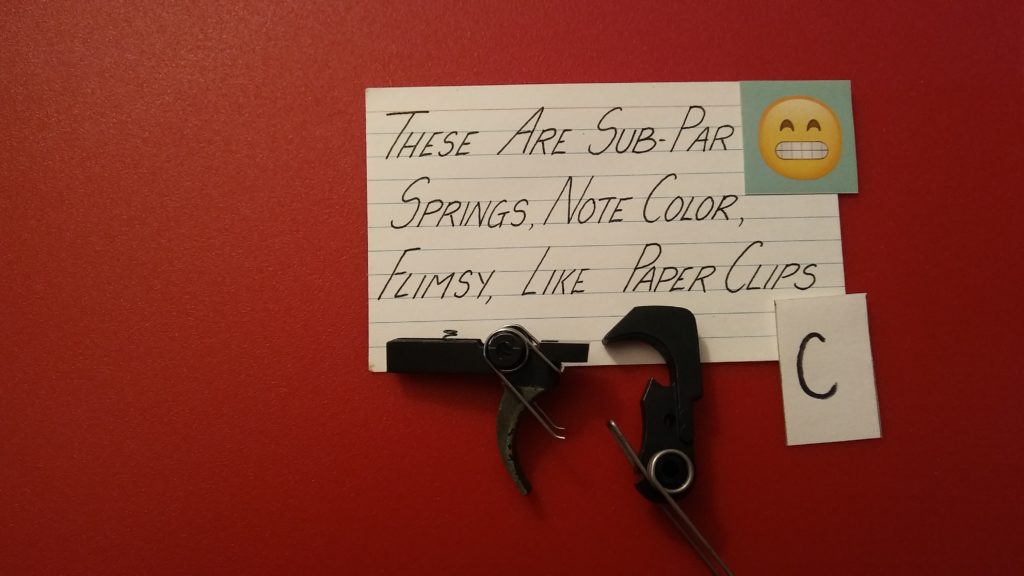
Using “paper clip” cheap parts typically results in poor reliability, and dampen the spirit of our DIY people.The triggers in the kits seem to be okay, with no major issues thus far, but don’t cheap out on your stuff like lower parts kits. The LPK comes “free” with the kit, and that’s a good thing, because a lot of the components aren’t so great.
You can’t blame people for trying to learn skills while also saving money, but sometimes the end products are rather shabby.Another caveat is this- don’t go buying a bunch of stuff if you can’t do the work. Seek out someone who has their stuff together, and chances are they’ll help you out.
Fire Control Groups (FCG)- Let’s boil this down to the Hammer, Trigger, Disconnector, and their associated springs. We’re not concerning ourselves with the Safety Selector for this installment. With your stock FCG, you’ll get years of trouble free service, but eventually stuff will wear out. Following will be one method of associating parts in an easy fashion.
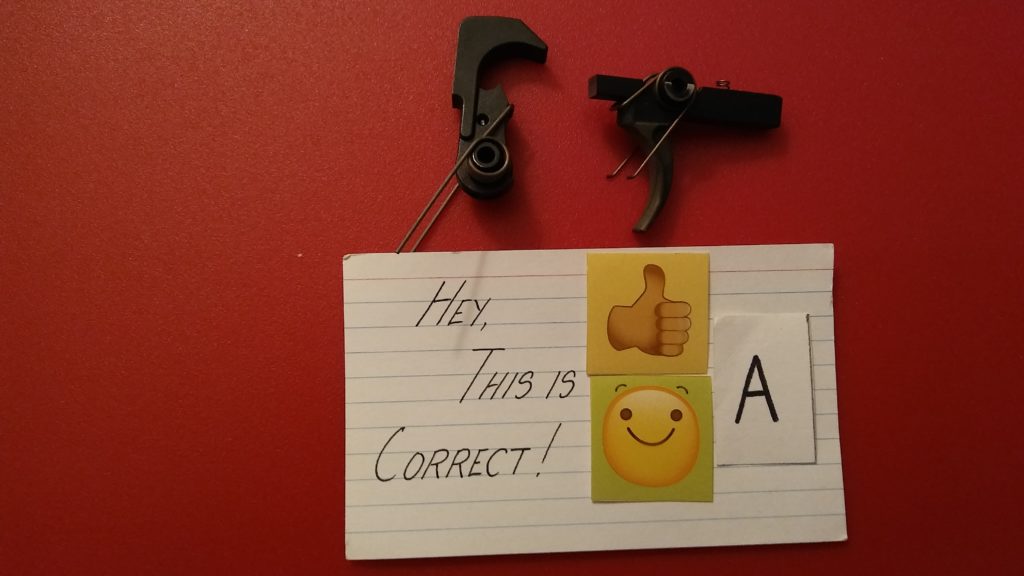
Imagination and Association- The spring placement is pretty straight forward, and people rarely mess this one up, but it occasionally happens. Where people tend to mess up the most is with the hammer spring.
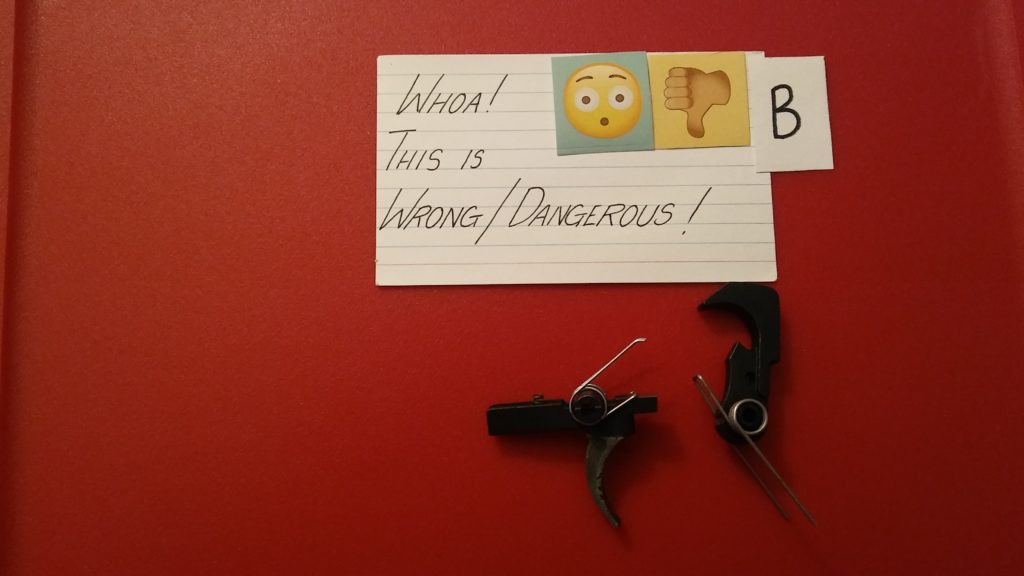
The hammer kind of resembles a bottle opener, and if you look at the spring legs, the bottoms face the “hook” on the opener, if placement is correct.
If the spring is backward, the firearm will give you several clues that you must be wise enough to detect. These include (but not limited to) a lighter feeling trigger press, failures to fire, with light primer strikes. This happens because the necessary engagement is barely present, which can make things incredibly dangerous. The gun may fire more than 1 round at a time, and this is an obvious red flag, because semiauto firearms don’t do this.
This arrangement can also cause hang fire (at this point, if some of these terms are perplexing, you need to do some research). This is exactly why we keep the muzzle in a safe direction at all times.The most obvious flag that something is wrong (if you’ve somehow missed all the OTHER clues) is that the frame pins keeping all the parts tucked into the lower will start to wander out of the lower. This calls for an immediate cease fire, and clear the firearm promptly. Don’t use it until proper repairs are made, and do not attempt to force the pin(s) back in.
Having said all that, let’s look at an accessory that can hide some of the effects of a mispositioned hammer spring. Anti Walk, or, Anti Rotation Pins- Like absolutely every little thing in this sport, there are those who feel that these pins aren’t needed. If you’ve ever had a lower that suffers from oversized frame pin holes, you need a set of anti walks to keep the firearm chugging along.
Lowers are aluminum and frame pins are steel. With high volume firearms, the pin holes can get distorted. This is a valid need. Another valid need is for a lot of after market triggers. Many of these triggers require anti walks to keep everything lined up correctly.
There are also those people who just slap on a set for decoration, just because. This doesn’t hurt anything, but it’s kind of silly. Everyone likes to personalize their stuff, and this is 1 more way to do so. The act of personalization pays the bills for over half of the stuff out there for the AR platform. Then there’s the bad thing about anti walks. We discussed earlier that you can have a somewhat functional firearm with an incorrectly installed hammer spring.
We discussed that one very big clue to this are the pins walking out. With the anti walks installed, the pins cannot leave the lower. This means that at your range or perhaps in the clases you go to, there may be someone in your midst with a fairly unstable firearm, which isn’t good. The more time you spend training, the more the probability goes up. So, if you see these types of symptoms mentioned previously, that might be a dandy time to call for a cease fire, and have a pro examine the firearm in question.
Disconnectors- Now we get into the disconnector, or “disco”. Here’s a tip with discos and springs, if either are worn out toss away both. They’re cheap, and if 1 is worn, so is the other one. Now for the FCG, we have Nessie riding on the Elephant, with both facing the Bottle Opener. It only takes 1/1000th of an inch for a disco to go wonky. If you’re a consistent high volume shooter, you will indeed go through them.
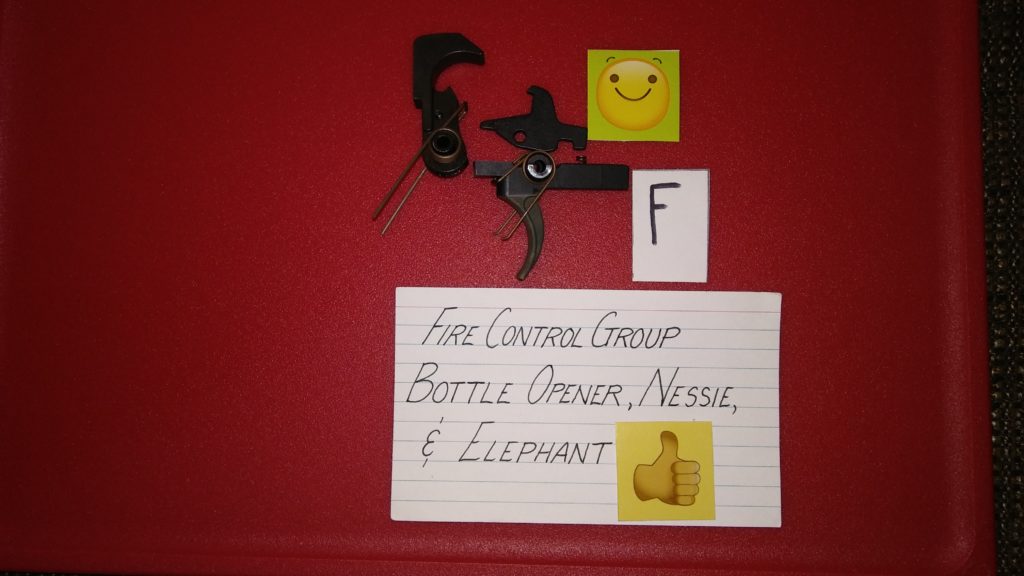
We’re looking down on the elephant head (trigger) and we can see the slot, and a silver spring (this is for the disco). Note the 2 parts that form the elephant eyes, and you’ll see a faint circular machining divot. This area allows a loose 223 primer to fit perfectly in there
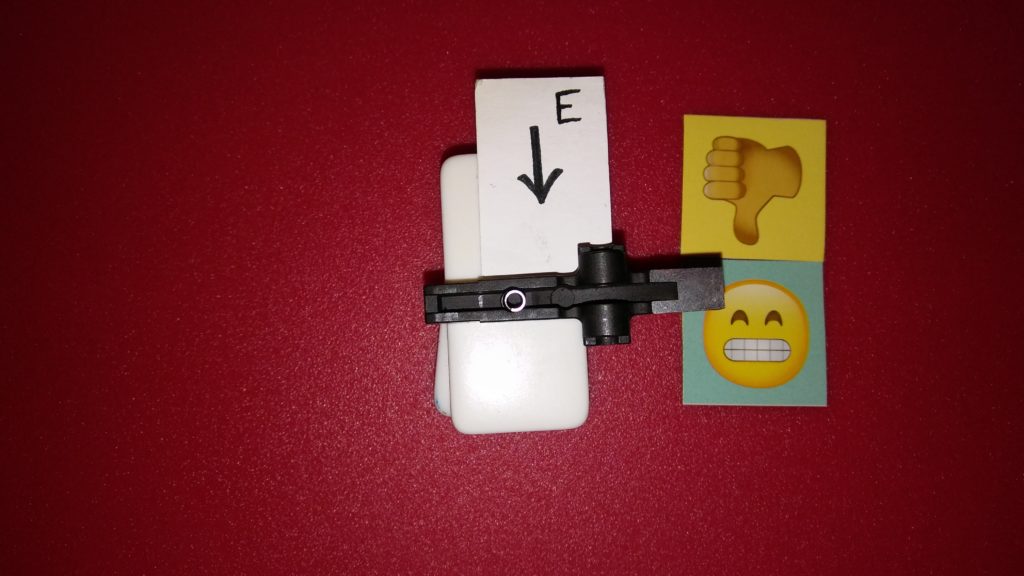
I share this because it happened to me a few years back. During test fire after replacing a different component, a primer lodged in this area, and the remaining rounds in the magazine (18 rounds, to be precise) left the muzzle at basically full auto cyclic rate.
The word surprise is an understatement. I’d not ever experienced this before, but if you own enough Armorer Manuals, you’ll see that it’s in some of them. This happens enough that it’s notated, but one time was enough for me. If you’ve got presence of mind during something like this knock the magazine towards yourself, as this may take things out of battery. The main thing to be certain of however, is that muzzle in a safe direction.
So there you have it, some things about stock triggers that maybe you didn’t know. In typical fashion I went too long, and apologies for that.
Until Next Time, Stay Safe, Train Often




